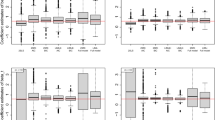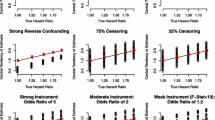Abstract
Instrumental variable (IV) methods are widely used to deal with the issue of unmeasured confounding and are becoming popular in health and medical research. IV models are able to obtain consistent estimates in the presence of unmeasured confounding, but rely on assumptions that are hard to verify and often criticized. An instrument is a variable that influences or encourages individuals toward a particular treatment without directly affecting the outcome. Estimates obtained using instruments with a weak influence over the treatment are known to have larger small-sample bias and to be less robust to the critical IV assumption that the instrument is randomly assigned. In this work, we propose a weighting procedure for strengthening the instrument while matching. Through simulations, weighting is shown to strengthen the instrument and improve robustness of resulting estimates. Unlike existing methods, weighting is shown to increase instrument strength without compromising match quality. We illustrate the method in a study comparing mortality between kidney dialysis patients receiving hemodialysis or peritoneal dialysis as treatment for end-stage renal disease.


Similar content being viewed by others
References
Angrist JD, Imbens GW, Rubin DB (1996) Identification of causal effects using instrumental variables. J Am Stat Assoc 91(434):444–455
Baiocchi M, Cheng J, Small DS (2014) Instrumental variable methods for causal inference. Stat Med 33(13):2297–2340
Baiocchi M, Small D, Lorch S, Rosenbaum P (2010) Building a stronger instrument in an observational study of perinatal care for premature infants. J Am Stat Assoc 105(492):1285–1296
Baiocchi M, Small DS, Yang L, Polsky D, Groeneveld PW (2012) Near/far matching: a study design approach to instrumental variables. Health Serv Outcomes Res Methodol 12(4):237–253
Belloni A, Chen D, Chernozhukov V, Hansen C (2012) Sparse models and methods for optimal instruments with an application to eminent domain. Econometrica 80(6):2369–2429
Belloni A, Chernozhukov V, Hansen C (2010) Lasso methods for gaussian instrumental variables models. arXiv:1012.1297
Bound J, Jaeger DA, Baker RM (1995) Problems with instrumental variables estimation when the correlation between the instruments and the endogenous explanatory variable is weak. J Am Stat Assoc 90(430):443–450
Brookhart MA, Schneeweiss S (2007) Preference-based instrumental variable methods for the estimation of treatment effects: assessing validity and interpreting results. Int J Biostat 3(1):1–25
Caner M, Fan Q (2010) The adaptive lasso method for instrumental variable selection. Technical report, working paper, North Carolina State University
Derigs U (1988) Solving non-bipartite matching problems via shortest path techniques. Ann Oper Res 13(1):225–261
Garabedian LF, Chu P, Toh S, Zaslavsky AM, Soumerai SB (2014) Potential bias of instrumental variable analyses for observational comparative effectiveness researchpotential bias of instrumental variable analyses for observational cer. Ann Intern Med 161(2):131–138
Goodlad C, Brown E (2013) The role of peritoneal dialysis in modern renal replacement therapy. Postgrad Med J 89(1056):584–590
Heaf JG, Løkkegaard H, Madsen M (2002) Initial survival advantage of peritoneal dialysis relative to haemodialysis. Nephrol Dial Transpl 17(1):112–117
Imbens GW, Angrist JD (1994) Identification and estimation of local average treatment effects. Econometrica 62(2):467–475
Jiwakanon S, Chiu YW, Kalantar-Zadeh K, Mehrotra R (2010) Peritoneal dialysis: an underutilized modality. Curr Opin Nephrol Hypertens 19(6):573–577
Kim H, Kim KH, Park K, Kang SW, Yoo TH, Ahn SV, Ahn HS, Hann HJ, Lee S, Ryu JH, Kim SJ, Kang DH, Choi KB, Ryu DR (2014) A population-based approach indicates an overall higher patient mortality with peritoneal dialysis compared to hemodialysis in korea. Kidney Int 86(5):991–1000
Korevaar JC, Feith G, Dekker FW, van Manen JG, Boeschoten EW, Bossuyt PM, Krediet RT (2003) Effect of starting with hemodialysis compared with peritoneal dialysis in patients new on dialysis treatment: a randomized controlled trial. Kidney Int 64(6):2222–2228
Kumar VA, Sidell MA, Jones JP, Vonesh EF (2014) Survival of propensity matched incident peritoneal and hemodialysis patients in a united states health care system. Kidney Int 86(5):1016–1022
Li L, Greene T (2013) A weighting analogue to pair matching in propensity score analysis. Int J Biostat 9(2):215–234
Li Y, Lee Y, Wolfe RA, Morgenstern H, Zhang J, Port FK, Robinson BM (2015) On a preference-based instrumental variable approach in reducing unmeasured confounding-by-indication. Stat Med 34(7):1150–1168
Lu B, Greevy R, Xu X, Beck C (2011) Optimal nonbipartite matching and its statistical applications. Am Stat 65(1):21–30
Lunceford JK, Davidian M (2004) Stratification and weighting via the propensity score in estimation of causal treatment effects: a comparative study. Stat Med 23(19):2937–2960
Marrón B, Remón C, Pérez-Fontán M, Quirós P, Ortíz A (2008) Benefits of preserving residual renal function in peritoneal dialysis. Kidney Int 73:S42–S51
Mehrotra R, Chiu YW, Kalantar-Zadeh K, Bargman J, Vonesh E (2011) Similar outcomes with hemodialysis and peritoneal dialysis in patients with end-stage renal disease. Arch Int Med 171(2):110
Neyman J (1923) On the application of probability theory to agricultural experiments. Stat Sci 5:463–480
Noordzij M, Jager K (2012) Survival comparisons between haemodialysis and peritoneal dialysis. Nephrol Dial Transpl 27(9):3385–3387
Normand SLT, Landrum MB, Guadagnoli E, Ayanian JZ, Ryan TJ, Cleary PD, McNeil BJ (2001) Validating recommendations for coronary angiography following acute myocardial infarction in the elderly: a matched analysis using propensity scores. J Clin Epidemiol 54(4):387–398
Rosenbaum P (2002) Observational studies. Springer, New York
Rosenbaum PR, Silber JH (2009) Amplification of sensitivity analysis in matched observational studies. J Am Stat Assoc 104(488):1398–1405
Rubin DB (1974) Estimating causal effects of treatments in randomized and nonrandomized studies. J Educ Psychol 66(5):688
Sinnakirouchenan R, Holley JL (2011) Peritoneal dialysis versus hemodialysis: risks, benefits, and access issues. Adv Chronic Kidney Dis 18(6):428–432
Small DS, Rosenbaum PR (2008) War and wages: the strength of instrumental variables and their sensitivity to unobserved biases. J Am Stat Assoc 103(483):924–933
Staiger DO, Stock JH (1997) Instrumental variables regression with weak instruments. Econometrica 65:557–586
Tam P (2009) Peritoneal dialysis and preservation of residual renal function. Perit Dial Int 29(Supplement 2):S108–S110
VanderWeele TJ, Arah OA (2011) Bias formulas for sensitivity analysis of unmeasured confounding for general outcomes, treatments, and confounders. Epidemiology 22(1):42–52
Vonesh E, Snyder J, Foley R, Collins A (2006) Mortality studies comparing peritoneal dialysis and hemodialysis: what do they tell us? Kidney Int 70:S3–S11
Weinhandl ED, Foley RN, Gilbertson DT, Arneson TJ, Snyder JJ, Collins AJ (2010) Propensity-matched mortality comparison of incident hemodialysis and peritoneal dialysis patients. J Am Soc Nephrol 21(3):499–506
Wooldridge JM (2001) Econometric analysis of cross section and panel data. The MIT Press, Cambridge
Zubizarreta JR, Small DS, Goyal NK, Lorch S, Rosenbaum PR (2013) Stronger instruments via integer programming in an observational study of late preterm birth outcomes. Ann Appl Stat 7(1):25–50. doi:10.1214/12-AOAS582
Acknowledgments
The authors have benefited from conversations with Michael Biaocchi. This project has been funded in whole or in part through funds from the National Institute of Diabetes and Digestive and Kidney Diseases, the National Institutes of Health, and the Department of Health and Human Services, under Contract No. HHSN276201400001C. Yun Li is funded by the National Institutes of Health (R01-DK070869).
Author information
Authors and Affiliations
Corresponding author
Rights and permissions
About this article
Cite this article
Lehmann, D., Li, Y., Saran, R. et al. Strengthening Instrumental Variables Through Weighting. Stat Biosci 9, 320–338 (2017). https://doi.org/10.1007/s12561-016-9149-9
Received:
Revised:
Accepted:
Published:
Issue Date:
DOI: https://doi.org/10.1007/s12561-016-9149-9




